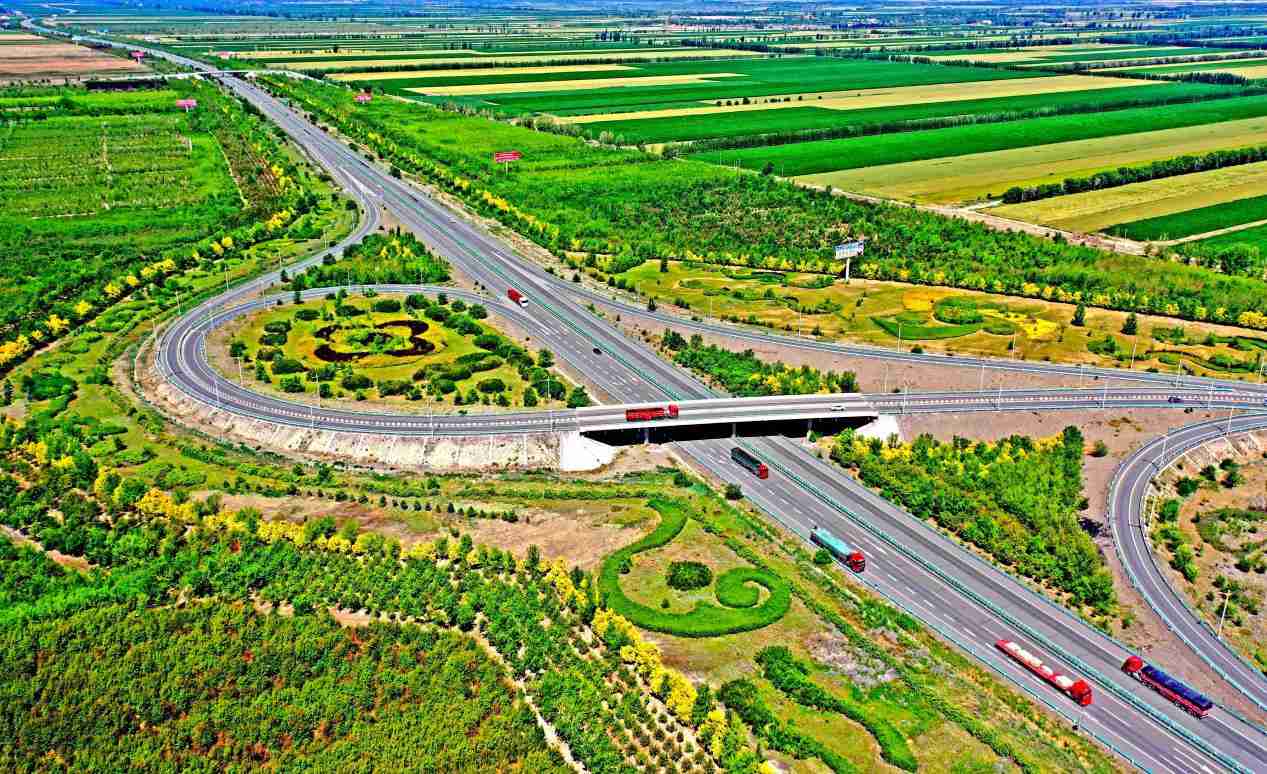World's longest desert-crossing expressway starts operation
The Beijing-Urumqi Expressway, the world's longest desert-crossing expressway, fully opened to traffic on June 30 after its last section in northwest China's Xinjiang Uygur Autonomous Region was put into operation. The expressway, also known as G7 expressway, is now the fastest road linking northeast, north and northwest China.
The expressway is the seventh national expressway originating from the capital city of Beijing. Totaling 2,822 kilometers, it crosses six provincial-level regions including Beijing, Hebei province, Shanxi province, Inner Mongolia autonomous region, Gansu province, and Xinjiang Uygur autonomous region.

Photo taken on June 28, 2021 shows the Qitai section of the Beijing-Urumqi Expressway in northwest China's Xinjiang Uygur autonomous region. (Photo by Cai Zengle/People's Daily Online)
The Beijing section of the expressway was opened on May 24, 2014, and the section linking Inner Mongolia Autonomous Region's Linhe and Xinjiang Uygur Autonomous Region's Baigeda started operation about three years later. The section opening this time has a total length of 515 kilometers, and goes in two directions with four lanes where vehicles can run as much as 120 kilometers per hour. It is the first expressway in Xinjiang built under public–private partnership, as well as the longest operational expressway opened at one go in China.
The expressway marks the completion of the north channel of the Silk Road Economic Belt, and will give a strong boost to Xinjiang's economic and social development, said Da Wenbin from China Railway Construction Investment Group Co., Ltd., who's in charge of the Beijing-Urumqi Expressway project. It is a road to wealth, unity and happiness, he added.

Asphalt is being laid at the junction of an extended section of the G575 expressway and the Beijing-Urumqi Expressway, May 20, 2021. (Photo by Polat Niyaz/People's Daily Online)
Crossing Ulan Buh Desert, Tengri Desert and Badain Jaran Desert, the Beijing-Urumqi Expressway shortens the journey between Beijing and Urumqi, capital of Xinjiang Uygur Autonomous Region by nearly 1,300 kilometers. It is a witness to the mutual assistance and solidarity among the people of all ethnic groups along the route.
Over 20 years ago, Zhang Xinjian went from his hometown Hubei province in central China to Xinjiang International Grand Bazaar in Urumqi to sell dried grapes, where he came to know Sulayman Memetimin, owner of a copper handicraft shop. The two developed ironclad friendship during the past two decades and are calling each other "family".
In 2019, Sulayman wanted to move his shop to a better location in the grand bazaar. It was Zhang that lent him 60,000 yuan ($927.95) to make it happen. This year, when Zhang was having the interior of his new shop decorated, Sulayman also went to help. "

Vehicles drive onto the Beijing-Urumqi Expressway from a tollgate in Yiwu county, northwest China's Xinjiang Uygur autonomous region, June 30, 2021. (Photo by Cai Zengle/People's Daily Online)
Xiao Yumei was once an impoverished villager living in Disanbu village, Huai'an county in northwest Hebei province, whose livelihood has been significantly improved after the opening of the Beijing-Urumqi Expressway. Xiao's house is only half an hour's drive from the Huai'an exit of the expressway. In recent years, under the assistance of local poverty alleviation cadres, an e-commerce platform was established to help local farmers sell millet, and four processing plants and a cooperative have been built. Nearly 60 percent of local millet production is processed and sold by the plants and cooperative.
"Now the millet is sold to Inner Mongolia Autonomous Region, and becomes a great ingredient of milk tea and fried millet," Xiao said. According to her, the expressway and e-commerce are helping her family gain over 10,000 yuan a year from the millet business alone.
Photos
Related Stories
- World's longest desert-crossing expressway in full operation
- World's longest desert-crossing expressway in full operation
- Duyun-Anshun expressway in Guizhou put into operation
- Zunyi-Yuqing expressway in Guizhou
- Massive expressway in Shaanxi to open to traffic at end of June
- Expressway construction reveals China's rapid development
- Smart expressway between Winter Olympic cities drives development
- Hainan's expressway in 100 seconds
- Beijing-Dezhou expressway under construction
- Construction of Chinese-built Nairobi expressway on top gear
Copyright © 2021 People's Daily Online. All Rights Reserved.










